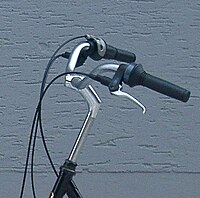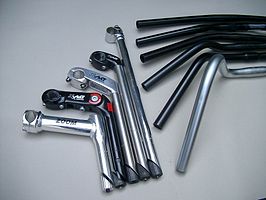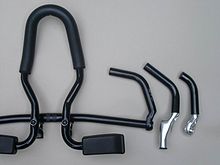Bicycle handlebars

The bicycle handlebar , also known as a guidon in Swiss , is (together with the saddle and the pedals ) one of the three areas of contact between the rider and the bicycle . It has an important function in steering direction, but it is by no means caused by the handlebars alone (see cycling ).
The bicycle handlebar generally consists of the actual handlebar and a stem , via which the handlebar is connected to the fork . The handlebar can be extended with additional grip points for the hands, for example with so-called bar ends . In addition to the handlebar grips, the handlebar also houses fittings (brake lever, shift lever, bell) and various accessories (speedometer, handlebar bag).
Colloquially, bicycle handlebars often only refer to the handlebar itself.
function
When the bicycle handlebars function, the handlebars must always be viewed in conjunction with the stem. Both components jointly bridge the distance between the rider's hands and the bicycle fork to be rotated; they are therefore decisive for the rider's sitting posture and, conversely, should be based on the desired sitting posture. The shape of the handlebar should provide ergonomically correct grip points for the hands, i.e. H. the right handlebar width and comfortable grip angles. The dimensions of the stem ensure that the handlebars are at the correct height and the correct distance from the saddle.
In addition to this division of tasks between the handlebar and stem, there are also one-piece bicycle handlebars:
- For cost reasons, the stem and handlebars are sometimes simply welded together (for example with the handlebars of simple Dutch bikes )
- For reasons of weight and stability, high-quality bicycle handlebars are designed in one piece without transition (for example triathlon handlebars, they are made entirely from carbon fiber reinforced plastic "Carbon")
- For functional reasons, there are also one-piece bicycle handlebars (e.g. adjustable handlebars).
- In the past, one-piece bicycle handlebars were widely used, especially on touring bikes .
Handlebar adjustment and posture
When adjusting the handlebars and stem, it should be noted that the correct position should only be assessed after a long period of riding. Immediately, a high handlebar positioned well forward appears particularly comfortable, which is why this setting is preferred by many people. In doing so, however, the driver adopts an unfavorable posture for the back, which can also be secondary to wrist pain. The buttocks are also heavily stressed. A handlebar that is set too high helps straighten the pelvis , which has a negative effect on cycling. In addition, a high handlebar reduces driving stability and thus driving safety. The problem exists in particular with current city bikes , the frame geometry of which additionally supports the unfavorable body posture. A handlebar is considered optimal if its handlebar grips are approximately at the same height as the saddle. An even lower handlebar enables optimal power development, but this requires increased body tension, which can only be maintained by trained cyclists.
Types of handlebars
The handlebar provides the grip points for the hands, but the height and depth of the handle in conjunction with the stem dimensions also influence the height and distance of the handles from the saddle. A distinction is made between (touring) brackets for a single sitting posture ( Holland , trekking , MTB handlebars) and brackets for several sitting postures (racing handlebars, multifunctional bars).
Touring bracket
Single posture brackets are relatively simply angled bars with handles on either end.
- Brackets for a sporty, forward-leaning posture are more straight and flat. This increases the distance to the saddle and maintains a low height above the steering column. The wrist position is horizontal so that the pressure line does not run through the ball of the hand, but along the base of the fingers. These temples are often too straight and cause problems in the shoulders and wrists. A slight angle both horizontally and vertically from the end of the handlebar towards the handlebar clamp is ergonomically more favorable.
- Brackets for an upright sitting posture are curved upwards in order to gain height. At the same time, they are angled sharply back to reduce the distance to the saddle. The handlebar ends are sloping slightly so that the wrists meet at a relaxed angle.
Between these two extreme handlebar shapes, there are various mixed forms for the moderate sitting postures.
Multi-position bracket
Brackets for several sitting postures have more elaborate bends in different directions and are usually padded along their entire length so that the driver can reach anywhere. This category includes the classic racing handlebars and the more up-to-date multifunctional bars in the shape of a figure eight.
Multiple grip positions are not synonymous with different sitting postures. Only those grip points that are in the direction of the supporting arms have an effect on the inclination of the back (e.g. with drop bars). If the grip points are perpendicular to the arms (e.g. a multi-function bar that is mounted like a car steering wheel), only the wrist or arm position changes, while the back tilt remains unchanged.
If there are several possible handle positions, only one position (main position) is provided with fittings (brakes, gearshifts); from all other positions (secondary positions), e.g. B. be reached for braking to the main position.
Fittings are only rarely installed several times on the handlebar via special branched lines.
Temple extensions
Handlebars can also be screwed on accessories such. B. the so-called bar ends , get more grip points.
For more extreme sitting postures, screwed-on support surfaces for the forearms are also common.
Triathlon handlebar
In the time trial and triathlon , since the mid-1980s, triathlon handlebars with aerobars have prevailed for the sitting position on long distances ( Ironman races), which enable athletes to sit in an optimal position with less air resistance with a forward extension. The driver's arms are brought close together, allowing an even more aerodynamic posture. The fittings are moved to the front here in the handlebar.
Handlebar grips / handlebar tape / handlebar covers
Padding is attached to the designated grip points on the handlebar for the driver's hands. They distribute the pressure better than the bare thin metal tube, offer a secure hold and absorb vibrations. In the case of a single grip point, handles are usually the width of a hand pushed on; in the case of several grip positions over a longer area, usually wound handlebar tape or tubular covers are selected.
Handlebar grips are usually made of plastics, but can also, at least partially, be made of wood, cork, foam or leather. More elaborate specimens have gel pad inserts. Handlebar grips with an annular cross-section only increase the diameter of the handlebar. But they can also be oval or adapted to the shape of the hand in order to better distribute the pressure on the palm.
Handlebar tapes are self-adhesive strips made of plastic, textiles, cork or leather that are wrapped around the handlebar. They are available in a wide variety of colors and designs and their color design is often adapted to the bike. In professional cycling, they usually take up the design of the main sponsor .
To attach the handlebar tape , a short piece (about 5 cm) is cut off in order to cover the clamp of the brake lever, as otherwise a wedge-shaped point remains uncovered there. The winding begins at the open end of the handlebar, leaving an edge protruding, which is later bent around the edge and secured with a plug at the end of the handlebar. Care should be taken to keep the overlap as even as possible over the entire length. A figure-of-eight loop is placed around the brake levers, then the winding continues towards the middle.
The direction of the winding is ideally such that when the handlebars are turned backwards (pull towards the driver), the loose end of the winding is tightened rather than loosened. Finally, the end of the tape is secured with adhesive tape, such as electrical tape .
Handlebar covers are mostly foam tubes that are available in various hardnesses and surface structures.
Handlebar types - racing bike
Racing bike handlebars are initially divided into 3 basic shapes: classic , anatomical and ergonomic . The most commonly used handlebars these days is the Ergo handlebar, but the anatomical version is rarely found. The classic version can usually be found on classics such as the retro racing bike. This type of handlebar is sometimes still very popular with professionals.
The three basic forms can be subdivided into further types, such as compact , track , and randonneur .
- Classic : It owes its name to a long tradition. This variant is mostly used on racing bikes such as steel or retro racing bikes.
- Ergonomic : The features of this model are, on the one hand, the flatter drop (handlebar height) and the wide open arch downwards. This promotes a more upright sitting posture and avoids bending the back.
- Anatomical : This version has a straight curve, which should bring comfort, especially when driving on the lower links. The upper part is kept very flat and not as rounded as usual.
- Compact : Its features are a shorter reach (handlebar depth) and a lower drop (handlebar height). This makes driving on the lower link more comfortable and its flat shape makes it easier to operate gear and brake levers.
- Track : This type of handlebar was built for the posture of track cyclists. The middle on the top link is very narrow here, which is why it is also preferable to use the lower link with this type of handlebar. This variant is designed to drive without a brake lever, which makes it very popular with fixed-gear riders.
- Randonneur : The slight "U" shape enables a more upright sitting posture and is particularly suitable for long distances. In the past, this variant was often used in touring bikes in France, but today it is rarely used.
Dimensions
Handlebar center (cuff)
The cuff diameter must match the size of the stem clamp that holds the handlebar in place. For racing handlebars, different diameters from 25.4 mm upwards are traditionally common, depending on the manufacturer. For all other types of bicycles, a diameter of 25.4 mm (1 inch) is predominant; to increase stability, mountain bikes also have diameters of 31.8 mm or 35 mm.
Handlebar ends
The straight area of the handlebar ends up to the beginning of the first bend is called the handle length and accommodates all fittings (handles, brake levers, switches, bells). In general, a diameter of 22.2 mm (7/8 ") has prevailed for bicycle handlebars, but the previously common diameter of 23.5 mm is still standard for racing bars.
safety
The steering bar is one of the safety-relevant parts on the bike, that is, a breakage can (and usually will) lead to serious accidents, as the bike can no longer be controlled. Steering bars are wearing parts; to prevent breakage, they should be replaced at regular intervals. This applies not only to bicycles used for sporting purposes, but also and above all to bicycles that are used in normal city traffic. With heavy-weight cyclists, the loads there are usually higher than with light sports cyclists. Maximum loads occur when braking (constant load) and when accelerating (alternating load). However, wheels that have already fallen over can cause scratches and nicks in the handlebar surface, which represent weak points in the material and fail due to the effects of the notch effect even under low loads . Notches can also be created by cheap and poorly manufactured handlebar stems.
In order to prevent breakages, manufacturers have specified the following rules:
- In general, you shouldn't pay attention to the dimensions of the steering arm. For use in the city and cycling in your free time, a heavier steel bar is definitely preferable to a light aluminum or carbon bar. Steel deforms when overloaded, which means that breaks are more likely to be announced by deformations. Aluminum steering brackets, on the other hand, break brittle, that is, suddenly and unexpectedly.
- Not all steering bars are suitable for every use. The area of application must therefore be defined when purchasing.
- An extension of cross braces for reinforcement.
- No combination of steel stems and aluminum steering bars (material mix).
- The maximum tightening torque of the stem specified by the manufacturer must not be exceeded. Manufacturers usually test their handlebars and can guarantee these values.
- When transporting by car, the manufacturer recommends that the wheels should not be attached to the steering arm upside down, as the dynamic forces that occur can lead to material fatigue.
- In the event of damage, the steering arm must be replaced immediately.
- It is disputed whether handlebars, especially those of lightweight construction, should be replaced after ~ 5000 km or two years, whichever occurs first. There are clear recommendations in this direction from the manufacturers and also accessories distributors; in practice, many handlebars made of any material easily last for decades. A distinction between different types of handlebars is appropriate. The long lever arm of a straight MTB handlebar leads to higher loads in the area of the handlebar stem than occurs with narrower designs.
Other safety-relevant components on the bike: seat post , stem , crank , fork .
literature
- Fritz Winkler, Siegfried Rauch: Bicycle technology repair, construction, production. 10th edition, BVA Bielefelder Verlagsanstalt GmbH & Co. KG, Bielefeld, 1999, ISBN 3-87073-131-1











